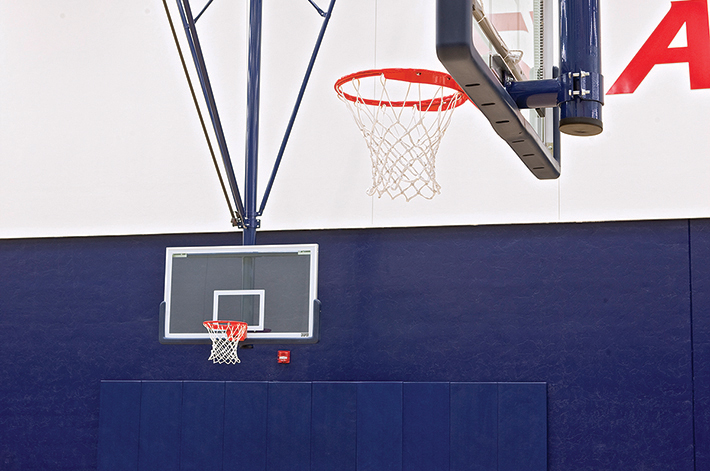
Standards Are Critical for Gym Safety
As a leading North American manufacturer of architectural gymnasium equipment, safety is a top priority for Draper, Inc. ASTM International standards play a vital role in helping us ensure our gymnasium products protect the safety of those who will be using them and the spectators watching.
There are two main product areas where ASTM standards are used to measure the safety of gym products.
Wall Padding
The most common standard used and cited in project specifications is the specification for indoor wall/feature padding (F2440). Released in 2004, this standard represented the first attempt to place performance requirements on protective pads used in gyms and other indoor athletic facilities.
The standard draws on the specification for impact attenuation of surfacing materials within the use zone of playground equipment (F1292) to determine criteria for acceptable performance. It requires a Gmax (maximum acceleration of a missile during testing expressed in units of acceleration due to earth’s gravity at sea level) of 200 or below and HIC (head injury criteria – a specific integral of the acceleration-time history of an impact used to determine relative risk of a head injury) of 1000 or below.
Prior to this standard going into effect, architectural specifications normally required a foam thickness and density. However, different wall pad foams of the same thickness and same density may not absorb impact equally. This standard motivated manufacturers to begin evaluating wall pad foams.
F2440 also mandates the maximum distance from the playing surface pads may be mounted: 4 inches. This protects players who might slide along the floor and into the wall. Before this requirement, some installers would place pads above receptacles or other obstructions to avoid making cut-outs. This would leave large areas without protection.
Draper also uses the test method for surface burning characteristics for building materials for flame testing of wall pads (F84). This method establishes flame spread and smoke development when a player protection pad is exposed to a flame. In athletic facilities, the results from this testing are used to classify wall pads according to the requirements of NFPA 101.
The test method for room fire test of wall and ceiling materials and assemblies (E2257) is also used for flame testing. Usually indicated as NFPA 286 testing in the gymnasium equipment world, this testing method is equivalent to E2257.
Basketball Backstops, Divider Curtains, Suspended Athletic Equipment
Draper utilizes several ASTM standards in the manufacture of these products. Standards are used to select components and test products. Here are some examples of standards we use and how they are applied:
- Standard Specification for Carbon Structural Steel (A36): Steel products made with sheet or strip steel of various shapes.
- Standard Specification for Electric-Resistance-Welded Carbon and Alloy Steel Mechanical Tube (A513): Tubing products that are the heart of most gym equipment products.
- Standard Test Method and Definitions for Mechanical Testing of Steel Products (A370): Strength testing for clamps and fittings.
- Grade A325 (SAE Grade 5) and ASTM F3125 – Grade A490 (SAE Grade 8); Specification for high strength structural bolts, steel and alloy steel, heat treated, 120 ksi (830 MPa) and 150 ksi (1040 MPa) minimum tensile strength, inch and metric dimensions (F3125): Hardware (nuts, bolts and other fasteners) must meet minimum requirements of one of these standards, depending on the application.
- Specification for heat strengthened and fully tempered flat glass (C1048) as well as the American National Standard for Safety Glazing Materials Used for Buildings: Glass used for backboards (AZ791.1).
Subcommittee F08.69
Although we follow ASTM standards in our manufacturing process, wall pads remain the only gymnasium products with set requirements. To remedy this, the subcommittee on commercially-installed sports-specific equipment for use in public venues (F08.69) was established to consider standards and guides for ceiling- and wall-suspended equipment in athletic facilities – products like basketball backstops, gymnasium divider curtains, overhead volleyball systems, batting/practice cages, wrestling mat lifters, etc.
Manufacturers of these products have traditionally been safety conscious and have had a good track record of supplying products with high levels of safety for users and spectators. However, there has never been anything that enumerated what was required to ensure safe products. Measures such as safety straps (load arrestors) for upward-folding equipment are considered an option and may not be used if not included in project specifications. The subcommittee is looking to close this and other loopholes to make sure everyone meets the same requirements.
There also has never been any firm guide that facilities can use for maintenance and inspection of gym equipment. Often this means no ongoing maintenance is done until something goes wrong.
Related products like bleachers/telescopic seating and playground equipment do have inspection/service standards and facilities generally adhere to those requirements.
Installation of these products is also a major concern. Even the safest product design is only safe if installed correctly. This group is also considering minimum requirements for people and companies installing these products. ■
Company Snapshot
Headquarters: Spiceland, Indiana, USA
Description: Draper is a leading manufacturer of gym equipment for the North American architectural market. We provide architects and designers with flexible gymnasium solutions that are custom designed to fit a specific facility. Draper also manufactures window shades, solar control solutions, projection screens, projector lifts, and AV structures for architectural, commercial, educational, and
residential markets.
Industries Serviced: Corporate, K-12 education, higher education, residential, retail, house of worship, corporate, government, live events, hospitality, healthcare, sports & entertainment, and transportation.
Trading Area: Global
 SN Home
SN Home Archive
Archive Advertisers
Advertisers Masthead
Masthead RateCard
RateCard Subscribe
Subscribe Email Editor
Email Editor